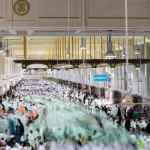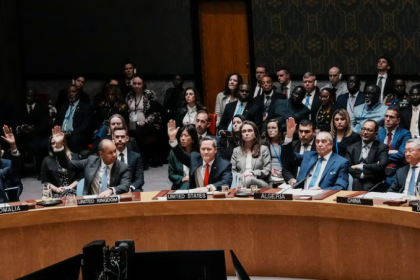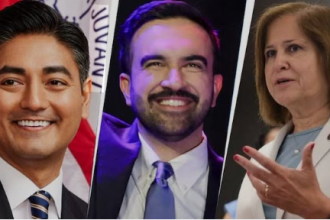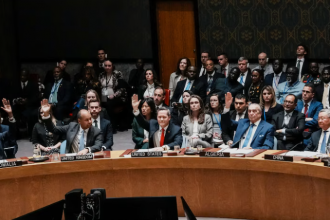Sep 29, 2025, LONDON: A leaked draft proposal for a postwar governing body in Gaza has raised alarm among Palestinian figures, who warn it would sideline them in favor of international officials and split Gaza from the Palestinian Authority in the West Bank.
The 21-page confidential document, seen and confirmed by The Guardian and Haaretz, outlined a Gaza International Transitional Authority headed by a chair with sweeping powers.
Among those suggested for roles are Sir Tony Blair, the former UK prime minister, Egyptian billionaire Naguib Sawiris, Marc Rowan of Apollo Global Management, and Aryeh Lightstone, a former adviser to US President Donald Trump’s ambassador to Israel.
Sources said the names were illustrative and used without permission.
The plan envisages a seven to ten-member council approved by the UN Security Council, with only one Palestinian member “from the business or security sector.”
The council would make “binding decisions,” issue legislation and oversee appointments, according to the document.
Its chair would “set the political and strategic direction for GITA” and lead diplomacy with Israel, Egypt and the US, without mention of the Palestinian Authority.
“You would have a council with a majority of foreign members legislating for Palestinians in Gaza,” said Xavier Abu Eid, a former member of the Palestinian Liberation Organization’s diplomatic negotiating team.
“There is already suspicion of Tony Blair because of the Palestinian experience when he was the Quartet representative (of the UN, US, EU and Russia mediation group). But the biggest is over what it means for Palestine as a single political entity, something that was recognized even by Israel in the Oslo Accords. This plan effectively legally separates Gaza from the West Bank and does nothing to explain how they will remain part of the same territory,” Eid added.
A source close to Blair said that while he had been involved in talks, “the guiding principle is that Gaza is for Gazans, with no displacement of the population.”
The sourced added: “We do not support or endorse any proposal that involves the displacement of Gazans. The document states that any transitional governing body for Gaza would ultimately return authority to the Palestinian Authority, as part of a pathway toward a Palestinian state.”
Mustafa Barghouti, general-secretary of the Palestinian National Initiative, told the Washington Post: “We’ve been under British colonialism already. He has a negative reputation here. If you mention Tony Blair, the first thing people mention is the Iraq war.”
The draft emerged ahead of an Oval Office meeting between US President Donald Trump and Israeli Prime Minister Benjamin Netanyahu.
Trump told reporters last week: “We are very close to a deal on Gaza.” He promised an immediate ceasefire, the release of all hostages within 48 hours, and a gradual Israeli withdrawal, according to Arab officials briefed on the plan.
What are the 21 points?
The following are the contents of the plan, which have been paraphrased at the request of the sources who provided it.
1. Gaza will be a de-radicalized, terror-free zone that does not pose a threat to its neighbors.
2. Gaza will be redeveloped for the benefit of its people.
3. If Israel and Hamas agree to the proposal, the war will immediately end, with the IDF halting all operations and gradually withdrawing from the Strip.
4. Within 48 hours of Israel publicly accepting the deal, all living and deceased hostages will be returned.
5. Once the hostages are returned, Israel will free several hundred Palestinian security prisoners serving life sentences and over 1,000 Gazans arrested since the start of the war, along with the bodies of several hundred Palestinians.
6. Once the hostages are returned, Hamas members who commit to peaceful coexistence will be granted amnesty, while members who wish to leave the Strip will be granted safe passage to receiving countries.
7. Once this agreement is reached, aid will surge into the Strip at rates no lower than the benchmarks set in the January 2025 hostage deal, which included 600 trucks of aid per day, along with the rehabilitation of critical infrastructure and the entry of equipment for removing rubble.
8. Aid will be distributed — without interference from either side — by the United Nations and the Red Crescent, along with other international organizations not associated with either Israel or Hamas.
The text of this clause appears intentionally vague and seemingly leaves an opening for the continued operation of the Gaza Humanitarian Foundation, as it technically is an American organization, even if it was the brainchild of Israelis linked to the government and was crafted to fit the Israeli government’s prosecution of the war.
9. Gaza will be administered by a temporary, transitional government of Palestinian technocrats who will be responsible for providing day-to-day services for the people of the Strip. The committee will be supervised by a new international body established by the US in consultation with Arab and European partners. It will establish a framework for funding the redevelopment of Gaza until the Palestinian Authority has completed its reform program.
This is the US plan’s first mention of the Ramallah-based PA. Israel has ruled out the authority as a potential ruler of Gaza, thereby nixing what has become the key to recruiting Arab assistance in the post-war management of the Strip, given that the international community views unifying the West Bank and Gaza under a single, reformed governing body as essential for long-term stability and peace.
The apparent decision to reserve the PA’s role for an unspecified later date will likely be a difficult pill for Ramallah to swallow, but it also has limited leverage to bear in these discussions.
Point nine appears to borrow heavily from former UK prime minister Tony Blair’s plan for ending the war, which was first revealed by The Times of Israel earlier this month.
Blair and former White House senior adviser Jared Kushner have been working on the Gaza file for months, while advising Witkoff.
10. An economic plan will be created to rebuild Gaza through the convening of experts with experience in constructing modern Middle East cities and through the consideration of existing plans aimed at attracting investments and creating jobs.
11. An economic zone will be established, with reduced tariffs and access rates to be negotiated by participating countries.
12. No one will be forced to leave Gaza, but those who choose to leave will be allowed to return. Moreover, Gazans will be encouraged to remain in the Strip and offered an opportunity to build a better future there.
13. Hamas will have no role in Gaza’s governance whatsoever. There will be a commitment to destroy and stop building any offensive military infrastructure, including tunnels. Gaza’s new leaders will commit to peaceful coexistence with their neighbors.
14. A security guarantee will be provided by regional partners to ensure that Hamas and other Gaza factions comply with their obligations and that Gaza ceases to pose a threat to Israel or its own people.
15. The US will work with Arab and other international partners to develop a temporary international stabilization force that will immediately deploy in Gaza to oversee security in the Strip. The force will develop and train a Palestinian police force, which will serve as a long-term internal security body.
16. Israel will not occupy or annex Gaza, and the IDF will gradually hand over territory it currently occupies, as the replacement security forces establish control and stability in the Strip.
17. If Hamas delays or rejects this proposal, the above points will proceed in terror-free areas, which the IDF will gradually hand over to the international stabilization force. This is the first mention of the possibility that the deal could be at least partially implemented, even if Hamas doesn’t agree.
18. Israel agrees not to carry out future strikes in Qatar. The US and the international community acknowledge Doha’s important mediating role in the Gaza conflict.
19. A process will be established to de-radicalize the population. This will include an interfaith dialogue aimed at changing mindsets and narratives in Israel and Gaza.
20. When Gaza’s redevelopment has been advanced and the PA reform program has been implemented, the conditions may be in place for a credible pathway to Palestinian statehood, which is recognized as the aspiration of the Palestinian people.
The clause doesn’t provide details regarding the Palestinian reform program and is not definitive regarding when the pathway to statehood can be established.
21. The US will establish a dialogue between Israel and the Palestinians to agree on a political horizon for peaceful coexistence.







